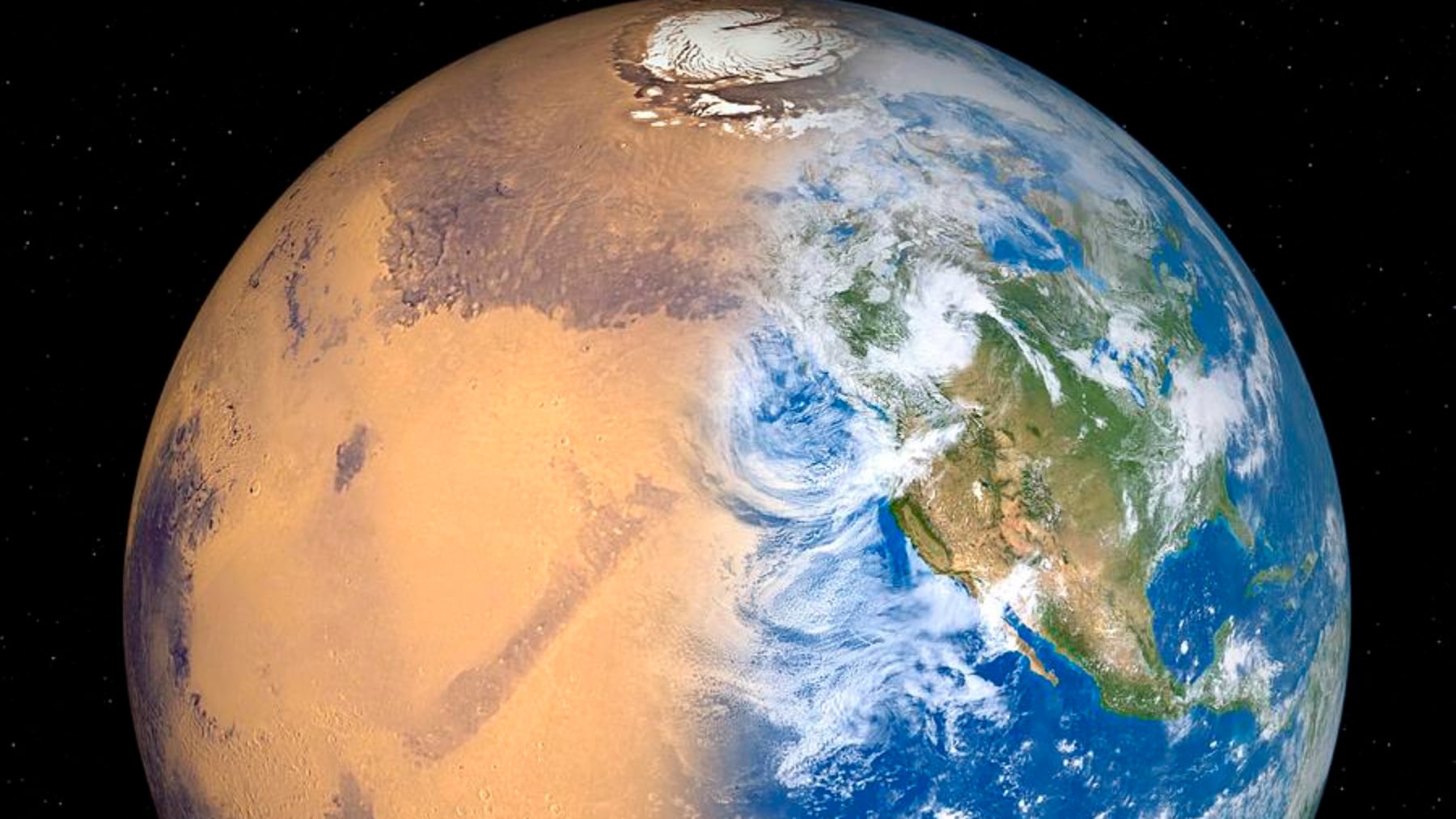For years and decades now the concept of terraforming Mars has kept researchers and science experts on their feet scratching their heads to find a solution. This enthusiasm came from various fictional novels and movies that have given scientists hope that perhaps they can implement this idea. According to research, Mars has the potential to be humanity’s second home and they are trying to make this concept a reality.
If Mars is ever to be terraformed, it will be a monumental task. Terraforming Mars could take decades or even centuries in its initial stages. Additionally, we do not have the technological capacity to implement this initiative. This sobering realisation highlights the enormous obstacles that stand in our way of realising the aim of altering the Red Planet. NASA needs to reassess the grand dream of Terraforming Mars
The dream or vision of making Mars a planet that can give life to humanity is an interesting one. This concept has been part of scientific language and conversation for decades now and it promises not to just give humanity a different perspective, but, also to serve as plan B as the Earth is changing. Scientists have hypothesised that humanity may establish conditions conducive to human life on Mars by releasing greenhouse gases and altering Martian.
NASA has admitted to this impossible mission stating that It is not possible to terraform Mars with current technology. Mars’ thin atmosphere and deficiency in vital resources such as enough carbon dioxide that would be required to start a greenhouse effect and warm the planet are the main obstacles. The idea of converting Mars into an environment more like Earth is significantly more difficult than first thought due to the harsh reality of the planet’s current status.
Therefore, the issue is not entirely based on technology, but also based on the enormity of the resources needed. Less than 1% of Earth’s atmosphere is found on Mars, and the planet does not have a magnetic field to shield it from cosmic radiation. It is therefore a wise idea for scientists and researchers to discard this idea since reports state that it could take thousands of decades to implement this idea. Unless a new technology advances enough to take on this big idea. Obstacles on the journey to a habitable Mars: Scientific, material, and time
Mars does not have the nature or resources that are similar to Earth that can even give us hope. If it comprises less than 1% of what the Earth attributes, then it could be a waste of time, resources and investments. Due to the abundance of carbon dioxide in our atmosphere (earth), heat is retained and a rather stable climate is produced. Mars’s sparse atmosphere prevents the planet from efficiently retaining heat.
According to Bonsor (n.d.), NASA is reportedly developing a solar sail propulsion technology that would harness solar energy to power spaceships through the use of enormous reflective mirrors. Placing these massive mirrors a few hundred thousand kilometres away from Mars would be another way to use them: to heat the Martian surface by reflecting solar radiation.
NASA has found that, even in the event that all of Mars’ CO2 could be released, the atmospheric pressure required for human survival without a spacesuit would not be produced. The entire accessible carbon dioxide is insufficient to generate a habitable atmosphere, and transferring more gases from Earth or other celestial planets is currently beyond our technical capabilities.
The lack of a magnetic field on Mars presents another significant difficulty. The Earth’s magnetic field is essential for protecting the world from solar winds and dangerous cosmic radiation, which would otherwise remove our atmosphere. Mars has a thin atmosphere now because billions of years ago, the planet lost its magnetic field. It is just not possible to build an artificial magnetic shield using the technologies available today in order to terraform Mars.
The idea of terraforming may not be fully realised for several millennia, even though humans might visit Mars this century. It took the Earth billions of years to develop into a planet on which plants and animals could flourish. It is not an easy task to change the Martian landscape to resemble Earth. To create a livable environment and introduce life to the icy, arid planet of Mars, generations of human creativity and labour will be required (Bonsor, n.d).
Reality check for delusional people especially that goof that wants 1 million on mars in a couple of years
Well, if we can’t in this generation, terraform Mars, then hopefully we could at least clean up the planet we currently live on. It would be like trying to invest in a new home when you have paid off your mortgage, rather than trying to clean up the home you currently live in.
I hope that NASA’s declaration, detailed and understandable as it is, doesn’t unintentionally promote King Bazinga’s Mars A Lago grift and encourage credulous rubes to believe the carnival barker over the people that aren’t trying to sell shit.
I hope it does and we get Oceangate, space edition

Am I alone in thinking we as a species shouldn’t be wasting countless amounts of labor and resources on the stars when we have so many problems here at home?
It’s really never a choice of ‘which planet should we work on’. The problems on Earth can be solved, but not under capitalism and the current global power structure. Under a different system that could actually address the problems, there would be such a massive global effort underway to improve life on Earth, that some human exploration of Mars would be a tiny expenditure in comparison. As things stand, the problems aren’t permitted to be solved, so even if all space exploration was ended tomorrow, all that labor and resources would be redirected to the military or industrial research to boost the profits of corporations.
This only applies to the actual material reality. Billionaires and Musk-worshipers who delude themselves into thinking that Mars will let them escape climate change exist outside of that.
Far far smarter writers and philosophers than me have written on this topic. I think the general pitch was that terraforming a planet like mars was basically a new westward expansion and would kind of…maybe not “solve” but at least delay a lot of the problems we have at home.
It would be so, so, so much more expensive to terraform Mars than literally every project the entirety of humanity has ever undertaken combined. The whole point of stealing land on earth, like Manifest Destiny, is that it was an extremely cheap source of resources. There is not a single resource Mars could provide more cheaply than our home planet.
Mars itself maybe not but there’s definitely significant mineral deposits in the solar system that could be extracted, no? I don’t disagree it would be more expensive and difficult to terraform mars than anything else in the history of our species and the idea that we could do so under current conditions is hardly rational…but ultimately the system we live under requires and demands perpetual unending growth so that’s a circle you’ve got to square somehow.
Mars itself maybe not but there’s definitely significant mineral deposits in the solar system that could be extracted, no?
Are we short on mineral resources on Earth? It’s a big planet made of a whole bunch of minerals. What sort of enormous input of mineral resources would be required to effectively extract minerals from space? Certainly enough to make it an inviable approach.
You’re right that the system demands perpetual growth, but the reality is that’s a physical impossibility and space travel is too expensive to solve it. That’s going to be the key catalyst of system collapse that will end capitalism. Historically, the ecological limits of given techno-social regimes (not the planet as a whole, but specific means of organizing humanity and nature) are the cause of major systemic change. It’s simply a material inevitability that the current capitalist growth model will end. And then it’s just a matter of socialism or barbarism here on earth.
No, you’re definitely not alone in thinking this
Me, an alien, staring at Earth: “Listen, it’s a nice fantasy, but there’s no way anything can survive on that planet with the enormous amounts of corrosive and deadly oxygen. Also, the barometric pressure is way too low to support a colony. And don’t get me started on the solar radiation. You know what alpha rays do to our skin.”
I know I stole this opinion from a series of sci-fi books, but I like it.
Planets should not be terraformed. It’s vandalism of the natural world. If we are ever at the point where we have the technology to terraform a planet, we’ll just as easily be able to build artificial habitats in space.
It’s vandalism of the natural world.
That can be said about literally any endeavor to increase the productive capacity of a given piece of land though…
This isn’t a Marxist/Materialist position, is what I’m getting at.
There is still a dialectic between the artificial world and the natural world. Valuing nature is a dialectical position.
Based and correct honestly
I mean, “Nature” is a dialectic all in itself. It is at once both the ultimate origin of the human species, and everything with which we sustain & furnish ourselves; and at the same time it is the origin of every disease that would harm us, and of every condition & necessity that allows for one person to hold dominion over & abuse another. For that reason, it would be unwise not to attempt to make ourselves the masters of it.
But I would disagree that there is a “dialectic” between the “natural”, and the “unnatural”. That’s a position born either out of theology, or of pastoral romanticism. Instead one might say that there is a dialectic between those things which are the product of human society distinctly, and those things which are not, but both are in fact contained within the broader scope of the Natural.
Good points all around. I will say that I wasn’t using artificial to mean unnatural, merely to assert the dialectic you point out between human creation and nonhuman creation.
Otherwise we’d have to place bird nests and beaver dams into the category of artifice, and then things just get silly.
When there is a viable artificial alternative, in this case space habitats, I think terraforming is inexcusable.
Why increase the productive capacity of Mars if there is literally no reason to?
When there is a viable artificial alternative, in this case space habitats, I think terraforming is inexcusable.
Okay, but why? Particularly in the case of Mars, which doesn’t presently have an extant ecosystem.
Why increase the productive capacity of Mars if there is literally no reason to?
I mean people usually do not engage in extremely expensive infrastructure projects for the meme of it. That’s precisely why NASA said that we can’t do it, and should bother. The question is why you have a moral, rather than simply practical objection to this?
We do not increas the productive capacity of a given piece of land - we only go through successive decreases in productivity that we attempt to mitigate through new technological methods. With another planet, you’re starting from 0 productivity, and the prospect of increasing it is so outrageously expensive that it’s invalidated before it even begins.
We do not increas the productive capacity of a given piece of land - we only go through successive decreases in productivity that we attempt to mitigate through new technological methods.
That’s patently not true. If it were, then the general population of human beings on Earth would’ve remained steady since the dawn of agriculture, which even before the “industrial revolution” proper it hadn’t.
Your second point about terraforming a dead planet being more expensive than it’s worth, and being more-or-less impossible under current conditions (the whole point of the article in OP) I would tend to agree with though.
That’s patently not true. If it were, then the general population of human beings on Earth would’ve remained steady since the dawn of agriculture, which even before the “industrial revolution” proper it hadn’t.
That’s because we have continually been bringing new land and resources into production. If you’re a theory reader, Jason Moore’s Capitalism and the Web of Life is all about this idea and the dialectics of appropriation and exploitation that drive social change. It’s a really really good read.
What nature?
Far as we know,Mars is a dead rock. I agree that we should preserve hypothetical alien lifeforms,but what nature are we ruining by making an empty place livable?
As far as we know! There could be some extremely basic form of proto-life surviving off of minerals and radiation, or remnants of now extinct life when Mars had water, and that would be destroyed by terraforming.
Also? Geology (areology in Mars’s case) has scientific value and helps us understand the universe. Who knows what kinds of things we might discover in the Martian crust? We can learn so much about how planets form and about the ancient history of our solar system. Rocks aren’t worthless.
And there’s an aesthetic and cultural value to preserving the ancient landscape. It’s not “just” a rock anymore than mountains are “just” rocks. Shall we knock down the buttes and fill the canyons with concrete just because they’re rocks?
Keep Mars red!
I can see your point,but that doesn’t seem enough to just not settle any planetside areas because we’d “upset the natural scenery”.
I mean,I won’t oppose anyone who would want to live on Mars in the far future just because the environment would change.
I dunno,I never jived with the perspective that humans are supposed to just not interact with foreign environments and keep them in some sort of glass case only out of some weird quasi religious deference to “Mother Nature”.
Obviously,if we have the means,we should exercise extreme caution,but to flat out refuse to settle any planet other than this one seems silly in my opinion.
We don’t do it for some metaphysical “Mother Nature” but for each other. Defacing Mars would be robbing humanity of the natural beauty of the Martian landscape.
Mars has it’s own beauty that we can learn to appreciate, I think terraforming would rob us of the chance.
I just think that it shouldn’t be all forbidden.
Humanity can preserve sections of it for aesthetic or scientific purposes,but if it’s more cost effective than building an orbital arcology,then I would be in favor of that. I see it like this,we should prioritize the needs of human society first over preserving natural landscapes in the case where it would help us develop technologically. Again,with the caveat that all necessary precautions are taken first.
I understand your point about the value of things as they are to human science and society, but I personally think our needs should be put first in the purely hypothetical scenario where we can interact with with foreign planetary bodies. Also, wouldn’t terraforming offer valuable scientific data about how to curate and develop an ecosystem from the ground up? The Earth and other potentially habitable planets offer plenty of information, but wouldn’t some direct practice be also needed to create proper orbital ecosystems?
I would also like to point out that I am no where near an expert in biology or geology and I’m merely expressing the perspective I have with the limited information I have. I take full ownership of any lapses in my judgement and I will be the first to admit that whatever discrepancies there are in my beliefs are most probably caused by the limited knowledge I possess.
Don’t get me wrong,I’m no Muskite,and I wouldn’t lose any sleep over Mars staying the same,but if it’s deemed more efficient to terraform Mars over building orbital arcologies,I would back that policy.
My apologies for misinterpreting your sentiment,I just have a dislike for the people who act like we should swear off all development in the name of some idealistic notion of us being “caretakers” or “guardians” of nature because it just seems to be full of hubris. I see now that is not your position,and I want to clarify I didn’t intend to come off in a hostile way.
Humanity can preserve sections of it for aesthetic or scientific purposes,
Oh I don’t disagree! The natural world and the artificial world are in a dialectical relationship, one can not exist without the other. It seems entirely possible to reach a synthesis.
Forbidding humans from setting foot on Mars is pointless anyway, if it’s possible then it literally can not be truly forbidden because people will go there no matter what. People trespass in the Chernobyl exclusion zone, they’ll trespass on Mars too.
We’ve already disturbed the ancient landscape with our rovers anway, even if we painstakingly undid the damage it wouldn’t really be natural. It’d just be an artificial rehabilitation.
Humans can have a little bit of Mars, as a treat.
Anne Clayborne was right! Keep Mars Red!
You don’t necessarily need to terraform Mars.
Everyone is thinking Humans, land first, then live on there. I think we are putting the cart before the horse on this. Now getting a human there on the ground and back - doable. Just not the most practicable. Maybe somewhat suatainable but risky.
We have robotics, VR, cell and wireless tech. We can fairly easily build a space station around Mars. Set up a VR lab in the station and Avatar robots down there. I really am suprised we are not pioneering this tech with our current space station. Wouldn’t it be cool to walk up to an Avatar bot controlled by someone on the ISS? That would be a great moment. Robots cheaper than humans and the systems required to keep them alive. They can also build.
That way if the robot breaks down you just send another to replace / fix. No need to worry about human suits, tears, squishy living things. They’re all safe up in the station. The amount of work that can be done would be exponential. You wouldn’t need to worry so much about time delays or planning careful routes. So much more ground could be covered in much higher detail because you don’t need to worry so much about bandwith and power tranmission requirements, youxre just beaming to the local satellites which will beam it to the nearby station which will have far greater capabilities.
We can set up a logistics of power and refuling trains to go back and forth. Ion engines, batteries powered by the sun. Ect. You’d just need to get things into low Earth orbit and then hook up with your thrust module to get to Mars. You don’t need massive gargantuan Saturn V Starship rockets for everything.
We can absolutely do this. We can do it with the Moon too to really test it out.
Oxygen? Rocks. Iron OXIDE. Titanium diOXIDE. If you really want people. That’s a do-able thing I think. It just needs to be researched. We don’t have a need here because Oxygen is plentiful here. But I think this will be key to just make our own water rather than trying to find some underground hidden glacier in the shadow of a crater in the poles to sustain human life. Hydrogen is plentiful too. Make our own water, litterly squeezing water from a stone.
Lack of magnetic field, dynamo is what allowed Mars’ atmosphere to just leech off into space. My theory is a big asteroid punched it and created Olympus Mons where the core was ejected out / knocked out of comission. Reguardless we can’t fix that right now. Any atmosphere for humans is going to have to be contained within either a suit or a vessel.
We can store energy from the sun and ship it wherever it needs to go, and even have a logistics train to do this and refill them. Have a standardized battery pack adapter that can be swapped out. Use this to also build out a high bandwith communications relay network for the solar system and beyond. We can then set out satelites and telescopes in deep space without having to consider as large or power hungry communications on them since we will have relay networks to carry the signal.
This will be the step we need to take advantage of the resources out there and expand humanity to get off this rock and maybe just maybe find some ETs.
I really am suprised we are not pioneering this tech with our current space station.
We’re starting to get there. China’s Chang’e 4 far-side lunar rover was controlled via a relay satellite in a halo orbit around the L2 Lagrange point. But I think crewed science missions to Mars will have to be housed on the ground for a few reasons:
-
Solar particle radiation, such as from solar flares. Mars’ atmosphere, thin as it is, does help reduce this considerably despite the almost-nonexistent magnetic field. We’ve had radiation detection equipment on the surface of Mars for decades. We know exactly what to expect.
-
Synthesizing oxygen and methane using the Sabatier process for breathing and for refuelling a ship can’t be done from orbit. Since there has to be a ground station for the Sabatier machinery, then why not just keep the astronauts there too? It’s one less facility to maintain, and if they’re at the same facility, they’ll have access to effectively unlimited oxygen and water.
-
Orbital transfer windows are every 26 months. We’ve done 12 month stays on the ISS, but the astronauts and cosmonauts involved have had significant recovery time back here on Earth afterwards. 26 months in 0 G, plus the 3-4 month each-way travel time, may be too dangerous from a health perspective. 1/3 G might be enough to stave off the worst of bone and muscle loss. The amount of time the astronauts would have to exercise is reduced considerably from 0 G, and might not be needed at all if we’re lucky. We’ve had an entire evolution’s worth of time to experience 1 G, about a half century at 0 G, and a few weeks in 1/6 G. 1/3 G is a total unknown until we actually send well-informed fully-consenting healthy astronauts to see what it does to the human body.
-
Centrifuges to simulate gravity for humans like in the movie 2001 have never been put into space. The science is sound, but the engineering may be more complex than expected, there’s a lot of moving parts involved. This is something we need to do reliably and repeatedly in Earth orbit before trying it somewhere else.
Starship is actually the least-crazy way to get people and bulk cargo to Mars with current technology. Aerobraking around Mars definitely works, we’ve done it many times with uncrewed satellites and probes. Starship will take advantage of Mars’ atmosphere to bleed off most of its speed without having to carry a lot of fuel. Estimates are that about 98 to 99% of the transfer orbit speed can be bled off this way which is a massive fuel savings. The latest Starship flight test was a big success in demonstrating this capability. It made it all the way through re-entry and did a soft intact water landing in the Indian Ocean. Aerobraking at Mars is like a gentle breeze compared to the brutal pummelling that the successful IFT-4 Starship dealt with on its way down through Earth’s thick atmosphere from near-orbital speeds.
I think the sanest starting approach is a small science station on the surface of Mars. Start with just a few people for their 26-month tour, maybe a dozen or so NASA scientists and technicians who are highly educated on the risks and willing to go anyway. Just use the Starships themselves as bases to start, leased from SpaceX, but 100% controlled by NASA. Use orbital relays to control robots in real-time like China did with Chang’e 4.
(Insert my usual caveat here about how my respect for SpaceX is strictly for the people doing the real science and engineering there, and not the asshole who owns it.)
solar radiation
You’ll have to address it with shielding anyway
Synthesizing oxygen and methane using the Sabatier process for breathing and for refuelling a ship can’t be done from orbit.
Isn’t this done on the ISS already (for oxygen recovery)?
1/3 G is a total unknown
Low enough it won’t be great. Agreed that artificial gravity needs to be tested.
Starship is actually the least-crazy way to get people and bulk cargo to Mars
Have they even built the variant that is planned to take 100 tons to the moon?
Crewed missions to Mars are putting the cart before the horse - moon first, then decide how much you really want to go down another gravity well.
solar radiation
You’ll have to address it with shielding anyway
That can only be done with either staying close to a planet with a strong magnetic field like Earth, or putting more mass between the Sun and the astronaut. On an orbital station you need to bring your mass shielding with you, which thanks to the tyranny of the rocket equation quickly adds to the fuel requirements. On Mars’ surface the atmosphere will do a lot of the work. An ideal scenario also involves prefab storm shelters that sit on the surface of Mars and onto which dirt is piled. They don’t need to be complicated structures either.
One of my favourite ideas is to adapt the Bigelow expandable habitat design technology currently being used on the ISS for this. These types of modules take up relatively little size and mass when shipped, but expand to a large size. It’s sometimes called “inflatable” but that’s not quite accurate. It’s a rigid structure when deployed. The BEAM module was originally attached to the ISS for a planned 2-year test but it’s been so reliable and successful that it’s been kept attached permanently. Bigelow is pretty much out of business, but they transferred ownership of BEAM to NASA, and NASA contracts with the original engineering subcontractors that designed and built it. By space engineering standards it would be straightforward to adapt it into a Mars surface solar-storm shelter.
A surface base on Mars also has other major benefits, like being able to cool equipment by atmospheric convection. The only way to cool a spacecraft while not on the surface of a planet with an atmosphere is with radiators, which are big and heavy. The ISS has to have massive radiators, the big white panels that are perpendicular to the solar panels in this photo. And again, big and heavy radiator equipment means less cargo space/mass available for other supplies.
Synthesizing oxygen and methane using the Sabatier process for breathing and for refuelling a ship can’t be done from orbit.
Isn’t this done on the ISS already (for oxygen recovery)?
Not exactly. The ISS replenishes oxygen three ways. First is with a small-scale Sabatier system, but this is a fairly recent addition and can’t do the job on its own. It’s basically a small scale experiment to see if it can be done at all with relatively low power requirements and applied to future space stations. The test hardware on Perseverance is part of that research as well. The ISS mostly replenishes oxygen from gas canisters shipped from Earth on cargo supply ships. There’s also an electrolysis unit in the Zvezda service module that cracks water into oxygen and hydrogen using power from the main solar panels. But that electrolysis unit requires water as an input and the hydrogen is just vented into space. It’s as much about humidity control as it is about supplying oxygen. There’s also emergency oxygen candles available if all other supplies fail. All these systems just reduce the need for resupply, they don’t allow for long term self-sufficiency.
And if you’re doing long duration missions, crew comfort matters as well. Astronauts charitably describe the ISS as smelling like an old locker room. A Mars ground station running a larger-scale Sabatier process using atmospheric CO₂ could easily swap out the whole station atmosphere on a regular basis with no Earth resupply needed.
It also functions as an emergency oxygen backup. The average ISS astronaut needs only about 800 to 900 grams of of oxygen in a day and most Mars mission profiles estimate the same amount needed. The main oxygen tank in the current Starship design holds about 900 metric tonnes. Even if there’s no holding tanks for the Sabatier factory and all the oxygen and methane is pumped straight into a crewed landed Starship, when topped-up it would have enough oxygen for a dozen astronauts to breathe in comfort for roughly 240 years (give or take a few decades). The first Sabatier factory on Mars is probably going to be a customized Starship that has all the Sabatier equipment onboard, using its own tanks as holding tanks. With an orbital station, you’d need to figure out regular replenishment flights from the surface which adds wear-and-tear on equipment.
1/3 G is a total unknown
Low enough it won’t be great. Agreed that artificial gravity needs to be tested.
I’ve heard rumours that the CNSA is planning small-scale experimental centrifuges for their current station and future stations, like the planned but cancelled ISS Centrifuge Accommodations Module. Hopefully that engineering expertise will eventually translate into large-scale centrifuges like on the fictional Discovery One from 2001. I think that’s decades off at best though.
I wish the CNSA wasn’t so tight-lipped about civilian space technologies. They’re great for announcing scientific findings but frustratingly secretive about the engineering needed to make them. Even height-of-cold-war space-race NASA was better at public outreach.
Starship is actually the least-crazy way to get people and bulk cargo to Mars
Have they even built the variant that is planned to take 100 tons to the moon?
Not until they finalize the basic Starship design. They can’t do that until they nail down rapid reusability which will probably take another year or two of prototype flights. The good news on that front is that the Raptor engine is quickly becoming simpler and cheaper to manufacture, while also increasing thrust performance and reliability. They may be able to do a lot more than 100 tonnes lunar-landed mass at this R&D pace. The first few Starship/Super Heavy test flights had many problems with the old Raptor v1 engine, but the latest flight had had all but one of the v2 engines firing reliably for the full mission duration. The v3 engines are starting to get mass-produced and installed in prototype ships and boosters. The original Artemis III crewed landing timeframe of 2026 is pure fantasy, it ain’t gonna happen. But all the basic technologies needed to accomplish it are finally coming together. Assuming civilization doesn’t collapse I’d bet on 2026 for uncrewed landing tests, and maybe 2028 or so for a crewed flight to the Moon.
You’ll have to address it with shielding anyway
Radiation is a known quantity. You just store your water in your walls to shield against radiation
-
Everyone is thinking Humans, land first, then live on there. I think we are putting the cart before the horse on this
Agreed generally. Counterargument though- billionaires, land first, then live(?) on there. Totally sustainable and it even returns a whole lot of wasted, poorly-allocated and ill-gained resources back into the system on Earth for humanity to benefit from immediately. Highly practicable (and flexible, once they’re out of orbit it doesn’t matter where they go or if anything goes wrong), sustainable, and virtually zero risk (at most, the shuttles are a write-off- using catapults instead might remedy this).
The rest of the process you described can happen after, but I think this is the most appropriate course of action.
Counterargument though- billionaires, land first, then live(?) on there.
I like the vision, but I think just shooting them out of a cannon is probably going to achieve the same desired results with less expenditure.
We have robotics, VR, cell and wireless tech. We can fairly easily build a space station around Mars. Set up a VR lab in the station and Avatar robots down there. I really am suprised we are not pioneering this tech with our current space station. Wouldn’t it be cool to walk up to an Avatar bot controlled by someone on the ISS? That would be a great moment. Robots cheaper than humans and the systems required to keep them alive. They can also build.
That just seems like a more expensive, less reliable, less useful mars rover. Also, humanoid robots are terrible and incredibly prone to failure. Walking is an extraordinarily difficult act that has few inherent advantages over wheels. Lastly, how does VR help here?
I guess it doesn’t necessarily need to be humanoid. Or feet. We can develop these here and work out the kinks before Mars. Something to move around quicker than a caterpillar and can actually dig into the ground beyond a few inches, climb - do hills, build structures for humans before arrival.
VR helps in real time looking around. We use this type of tech in flying drones to get a more immersive control. Real time video. Real time actions instead of having to plan everything out and wait a month for 10 ft of movement. The current rovers we have were concieved in the 70s and they tend to reinvent the wheel with every iterarion. Expensive? More features will cost some money up front, but you don’t need to build custom suits which are prone to ripping and tearig with a human inside and losing s crew member. So there is cost and risk savings there.
The space station can be shielded from radiation. They will have less radiation than orbiting earth. Ion engines for logistics trains will cut times for resources to ship to the Mars stations. The logistics trains don’t need to interact with the atmospheres or lanching from ground. They can be recharged and refueld in space.
We don’t need to be limited to slingshots. Only having to send up to low Mars / Earth orbit for samples will reduce mission costs.
What is the benifet to humans here I suppose goes with the cost line. AI that isn’t used for genocide? More efficent costs of energy usage here at home? Standardized energy logistics to extend the life of other missions instesd of abandoning them? The ability to remotely upgrade and repair satelites. The ability to develop ion engines with reliable solar power outside the range of the sun for scalability. Improve the efficency and scalability of battery tech here on earth and eventually mining and tansporting the resources in space. By processing resources in space we don’t need to ruin our planet in getting them.
Eventually taking the next step to become a Type 1 civilization and ending scarcity.
 which I think is a far more noble goal and investment than blowing each other up.
which I think is a far more noble goal and investment than blowing each other up.
We can fairly easily build a space station around Mars.
Alright. Let me know where you’re at in a week.
I keep finding $10 to $20 billion in the couch cushions every few months, but
 keeps blowing it up in the burn pits of Gaza and Ukraine. Really amazing. Then they say NASA’s budget is cut again. No idea how this keeps happening. They did approve another 100-200 billion on top of the trillion dollar base war budget though so maybe the Space Force might be able to do it. Oh shit I just gave them ideas now!
keeps blowing it up in the burn pits of Gaza and Ukraine. Really amazing. Then they say NASA’s budget is cut again. No idea how this keeps happening. They did approve another 100-200 billion on top of the trillion dollar base war budget though so maybe the Space Force might be able to do it. Oh shit I just gave them ideas now!
Let’s just do something more reasonable instead, like a Dyson Sphere
What is a solar panel if not a very tiny contribution to a Dyson Sphere future?
*happy Icarus noises*
I’m more of a Dyson swarm kinda girl.
You’d have a hard time colonising Mars even if you had a portal, the soil is literally toxic y’all
Yeah, and we can’t even keep our own planet alive. We are slowly making our own air and soil toxic with all the plastics and industrial wastes we keep creating.
This article reads like it was LLM spew. I don’t know why exactly, it just has that vibe.
It’s the repeating information near the end
This is about terraforming, not settlement or visiting
That makes
 ’s clownish promises of multi-lane highways on Mars going to Martian suburbs and playing golf there with permanent (or at least certainly one-way) settlements even more clownish.
’s clownish promises of multi-lane highways on Mars going to Martian suburbs and playing golf there with permanent (or at least certainly one-way) settlements even more clownish.

Idk if I’d call this a particularly trustworthy news source. It feels extremely click-baity.
What’s the opposite of Terraforming? You know, the thing we’re doing here.
Disruptive Innovation

Personally I always thought the prospect of colonizing Mercury in a non-earth-like way at our current technology level made more sense (if not financial sense)- it could be done in subsurface caverns, harvest energy from the surface, ice is present inside permanently shadowed craters. Water is constantly being created from solar wind blasting the surface (sputtering creates water vapor when solar wind hits oxide-laden rocks. ).
The real problem? While the average distance between Earth and Mercury is only 48million km, around a third the distance to Mars (140 million km), the orbital speed is 47.87 km/s per second compared to Earth’s 29.78km/s, and Mars 24.08km/s. The transits could potentially be relatively short, but still end up consuming as many resources in the end. Mercury is also considerably less mass- while Mars and its gravity is 1/10th earths, Mercury is half that, which could have pretty bad long-term consequences for colonists.
What’s always intrigued me was air pressure and altitude. We all know air gets thinner as you go up, the inverse is true as well. A crater seven miles below “sea” level on Mars would have air pressure similar to the pressure of mountainous regions on Earth.
They’d probably still need a tent to block radiation, but they’d be livable breathable habitats. A few of these crater cities could dot the landscape while preserving the rest of Martian beauty, no terraforming required.
deleted by creator
The fundamental question of all space colonization - whether the planet next door or the other side of the galaxy - is: why? Who on earth would want to do that, and what could possibly be a sufficient economic incentive? Space travel is so outrageously difficult, expensive, and dangerous that it would without a doubt be easier to synthesize any special space resources (which probably don’t exist anyways btw). We don’t need the space because even Antarctic winters are cozier than the nicest day on Mars and population growth is about to level off globally.
It just doesn’t make any sense.
Like, what would we gain from colonizing Mercury?
In terms of other planets it really doesn’t make any sense outside of pure scientific exploration (frankly it’s a good thing that it doesn’t make economic sense) and for the strategy I described the moon is a better candidate anyways, for the reasons mentioned. That’s what the Chinese moon missions have been investigating at least.
Scientific outposts are literally the only plausible reason. And we can get 90% of that value without a single human stepping foot on the given body, especially as robotics tech develops.
And we can get 90% of that value without a single human stepping foot on the given body
Considering the toll long-term low gravity takes on people it’s almost certain that’s going to be the case. Having human habitats there is a lot of unnecessary complexity, but maintaining healthy humans in those conditions is categorically worse.
yea no shit
Duh. Terraforming a planet doesn’t make sense.


















